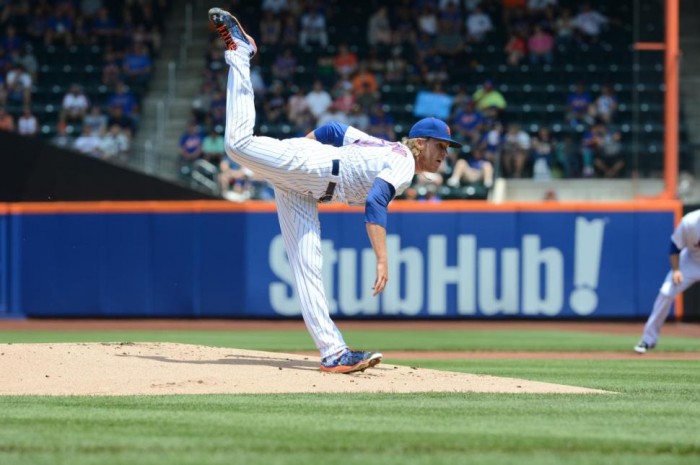New York Mets top prospect Noah Syndergaard made his highly anticipated Major League debut last Tuesday night in Chicago, coming away with a loss. The former Blue Jays prospect’s devastating potential and lack of experience was clear during his debut. He held the Chicago Cubs scoreless through five innings, demonstrating blazing speed on his fastball and nasty movement on his breaking pitches. His lack of control, however, led to an elevated pitch count. This, and several defensive lapses by Mets fielders, finally caught up with the budding star in the sixth inning. He gave up three runs, including a two-run homer, before he was taken out, throwing a total of 103 pitches in his debut. Opposite Syndergaard, Jake Arrieta (4-3) threw a great game for the Cubs, going eight innings and allowing only one run, while striking out 10 batters.
Syndergaard was dealt by the Jays as part of the R.A. Dickey trade with the Mets in 2012, having been drafted in the first round by the Blue Jays two years earlier. Since then, the Jays have received steady output and a reliable 200 innings pitched (IP) every year from Dickey, one of the game’s few true knuckleballers. Unfortunately, he hasn’t been the Cy Young pitcher that the Jays hoped for when they pulled the trigger. In fact, no other pitcher in the Majors has allowed more home runs than Dickey since he landed in Toronto.
Since the trade, Syndergaard has blossomed into an exciting prospect, and is now ranked inside the top 10 overall prospects by MLB.com and Baseball Prospectus. Scouts love him and it’s easy to see why: Syndergaard stands 6’ 6”, 242 lb., brings the hammer with a 98 MPH fastball that makes batters look foolish, and above-average secondary pitches that are dizzying.

(GIF courtesy of Rich MacLeod / MLB.com)
His greatest challenge in the big leagues will be limiting his walks and not relying on his fastball too much. He has to be aware that big-league hitters will eventually learn too time his heater, and that to succeed at this level he’ll need to keep them off balance by mixing his pitches well and commanding the strike zone.
During his debut, Syndergaard’s control issues came primarily against left-handed batters. He walked four, all lefties, (one intentionally) to go along with his six strikeouts in his 5.1 IP. His inability at points to get ahead of batters in the count hurt him twofold—it put runners on base and also kept him in innings longer than necessary, pushing his pitch count up.
Syndergaard rebounded well in his second start against the Brewers on Sunday, striking out five and walking just one over six strong innings to pick up his first Major League win. While he did plunk Carlos Gomez in the helmet with a 97 MPH fastball, it seemed like an aberration in an otherwise solid performance.
But one start for a rookie pitcher with command issues is nothing to get too excited about. The Chicago White Sox’s Carlos Rodon, another top prospect, impressed in his debut only to walk five in a disastrous outing his second time around. Syndergaard has already proven that he has big league stuff, though he hasn’t yet shown that he knows how to pitch like a big league pitcher. He’ll have to step up his game a bit to prove he belongs in the Majors.








